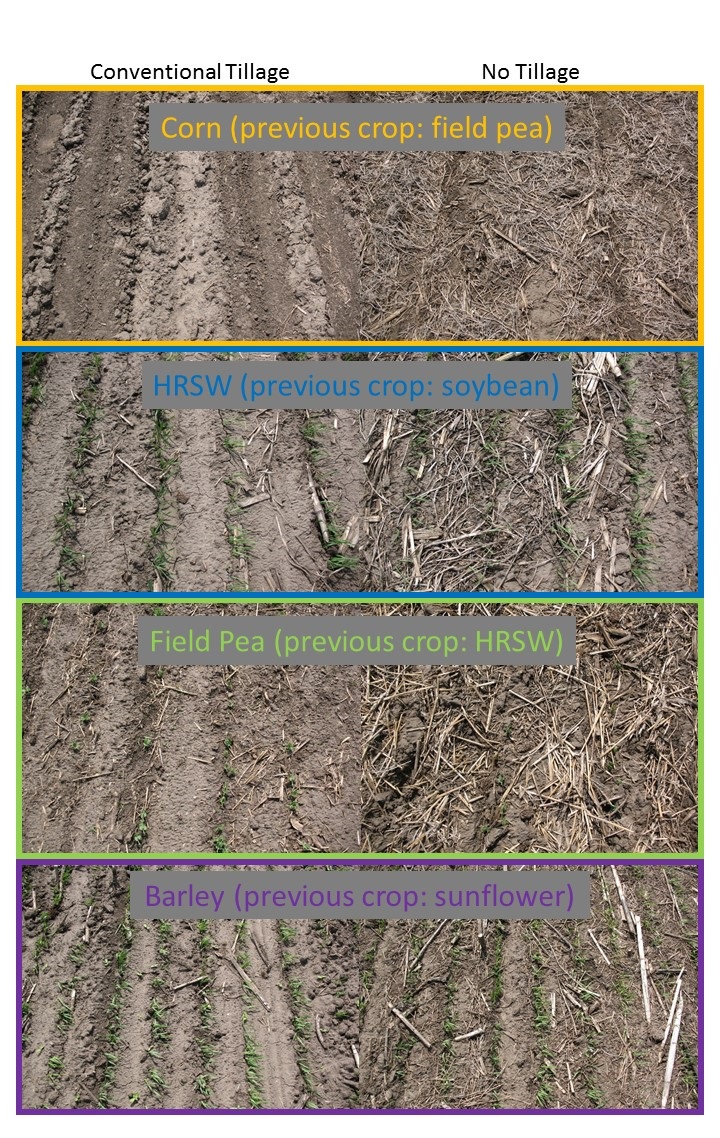Long-term Cropping Study – Tillage Systems
In 1987, a long-term cropping systems study started at the NDSU Carrington Research Extension Center. Three sets of 4-year crop rotations are replicated three times each year. The eighth cycle ended in 2015. The rotations and fertilizer treatments can be found here: https://www.ag.ndsu.edu/CarringtonREC/center-points/long-term-cropping-systems-study and the economics of the system can be found here: https://www.ag.ndsu.edu/CarringtonREC/center-points/economics-of-a-long-term-cropping-system-at-the-carrington-rec. In this blog, we’re going to discuss the tillage systems. This study is located on a Heimdal silt loam soil. The main plots are 180 ft. by 300 ft. so field scale equipment is used.
The conventional tillage system starts with disking to a depth of approximately three inches shortly after combining for weed control and to foster germination of volunteer grain. This is followed by chisel plowing later in the fall for weed control, to kill volunteer grain, and to create ridges to reduce wind erosion and to try to catch snow. In the spring, the ground is worked with a field cultivator prior to seeding or planting again for weed control and to prepare an appropriate seedbed for this treatment.
The minimum tillage has become more of a rotational tillage system. The minimum tillage system used to consist of chisel plowing in the fall followed by prepping in the spring with a field cultivator prior to seeding. It was changed to reflect current reduced tillage farming practices of the area. This is based on newer equipment that has reduced tillage and no-till capabilities. It is essentially not tilled except for the fall prior to the corn and sunflower rotations. That fall and the following spring it is worked just like the previously mentioned conventional tillage treatment. This is to help warm up the soil faster in our short growing seasons to give those crops as long of growing season as possible to try and capture as much yield as permitted by the growing season.
The no-till treatment is just as it sounds, there is no tillage performed except what disturbance is created by the disk drill or planter. Instead of tillage, a chemical burn down with herbicides is performed in the fall for weed control after combining and again in the spring for weed control prior to seeding. The no-till system greatly reduces soil erosion compared to the conventional tillage system. Also, it does not incorporate the crop residues into the soil like the conventional tillage system. Soil microbes use warm summer temperatures and moisture to grow their populations, thereby breaking down residues into organic matter. By reducing disturbance, the soil is able to build organic matter when the crop residues are broken down by soil microbes. Over time, this results in more plant available nutrients. This increase in soil organic matter allows for greater water infiltration due to the increased size and number of pores in the soil created from not disrupting its formation with tillage. Increased pore space also allows for more water holding capacity which can be used by the crop in times of moisture stress.
For every tillage system, appropriate herbicides are used for weed control within crop. Following are photos showing what a few of the tillage systems and various crops looked like early last week after seeding.
In these photos taken 5/9/16 you can see what the tillage systems look like after seeding. Conventional tillage is on the left and the no-till on the right. Top row: Corn (previous crop: Field Pea). Second row: HRSW (previous crop: Soybean). Third row: Field Pea (previous crop: HRSW). Forth row: Barley (previous crop: Sunflower).

The goal of the study is to determine the effects of tillage system, N fertility level and source, and crop rotation and the combination of these parameters have on crop grain and biomass production, crop diseases, soil nitrogen, soil phosphorous, soil organic matter, and soil pH.
I will be providing more updates as the season progresses.
Ezra Aberle
Agronomy Research Specialist


